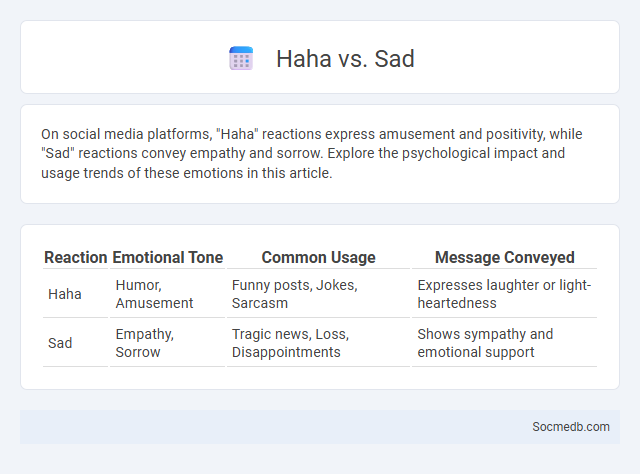
Photo illustration: Haha vs Sad
On social media platforms, "Haha" reactions express amusement and positivity, while "Sad" reactions convey empathy and sorrow. Explore the psychological impact and usage trends of these emotions in this article.
Table of Comparison
| Reaction | Emotional Tone | Common Usage | Message Conveyed |
|---|---|---|---|
| Haha | Humor, Amusement | Funny posts, Jokes, Sarcasm | Expresses laughter or light-heartedness |
| Sad | Empathy, Sorrow | Tragic news, Loss, Disappointments | Shows sympathy and emotional support |
Introduction to Social Media Reactions
Social media reactions encompass user interactions such as likes, comments, shares, and emojis that reflect real-time engagement and sentiment across platforms like Facebook, Twitter, and Instagram. These reactions provide valuable insights into audience preferences, brand perception, and content performance analytics. Analyzing social media reactions helps businesses optimize marketing strategies and enhance customer relationship management effectively.
Understanding "Haha" Reaction
The "Haha" reaction on social media platforms like Facebook represents amusement or laughter, often signaling a lighthearted response to content. Users employ this reaction to express humor, sarcasm, or playful teasing, providing nuanced feedback beyond a simple like. Analyzing "Haha" reactions helps brands and content creators gauge audience engagement and tone perception effectively.
The Meaning Behind the "Sad" Reaction
The "Sad" reaction on social media platforms expresses empathy and sorrow in response to posts about personal loss, tragedies, or challenging circumstances. This reaction helps users convey genuine emotional support without leaving a comment, fostering a communal sense of compassion. Widely used on platforms like Facebook, the "Sad" reaction enhances digital communication by allowing nuanced emotional expression beyond simple likes.
Why Reactions Matter on Social Platforms
Reactions on social media platforms provide real-time feedback that helps you gauge audience sentiment and engagement more accurately than likes alone. They enable algorithms to prioritize content that resonates emotionally, increasing your visibility and reach. Understanding the impact of reactions allows your content strategy to align better with audience preferences and boost overall interaction.
Psychological Impact of Different Reactions
Social media interactions significantly influence users' psychological well-being, with positive reactions like likes and supportive comments enhancing self-esteem and promoting a sense of belonging. Conversely, negative feedback or lack of engagement can trigger feelings of anxiety, depression, and social rejection. Studies show that the dopamine release linked to social media validation reinforces addictive behaviors and shapes emotional responses to digital communication.
Cultural Differences in Interpreting Reactions
Social media reactions vary significantly across cultures, reflecting diverse communication styles and social norms. In collectivist societies, expressions of agreement or disagreement may be more indirect and context-dependent, while individualistic cultures tend to show more explicit and direct feedback. Understanding these cultural nuances is crucial for accurately interpreting online interactions and avoiding miscommunication.
When to Use "Haha" vs "Sad
Use "Haha" on social media to express genuine amusement or lightheartedness, enhancing positive engagement and conveying humor clearly in comments or messages. Reserve "Sad" for moments of empathy, loss, or disappointment to authentically communicate feelings of sorrow and foster emotional connection with others. Selecting the appropriate reaction emoji or phrase improves tone clarity and strengthens social interaction on platforms like Facebook, Twitter, and Instagram.
Analyzing Audience Engagement with Reactions
Analyzing audience engagement with reactions on social media provides key insights into user sentiment and content effectiveness. Tracking metrics such as likes, loves, wows, and angries helps identify emotional responses and tailor future posts for higher impact. Optimizing content based on reaction patterns increases overall engagement rates and fosters stronger community connections.
Benefits and Drawbacks of Reaction Buttons
Reaction buttons on social media platforms enhance user engagement by allowing quick, expressive feedback beyond simple likes, fostering a more nuanced interaction. They provide real-time emotional insights, helping content creators and marketers gauge audience sentiment and tailor their strategies effectively. However, these buttons can also oversimplify complex emotions and potentially polarize discussions by encouraging reactive rather than thoughtful responses.
The Future of Emotional Reactions Online
The future of emotional reactions online is characterized by increasingly sophisticated AI algorithms that analyze and predict user sentiments with high accuracy. Advances in neuro-responsive technologies and sentiment analysis tools enable platforms to tailor content dynamically, enhancing user engagement through personalized emotional experiences. Emerging virtual reality environments further immerse users, allowing the expression of complex emotions through avatars and real-time biometric feedback.
 socmedb.com
socmedb.com